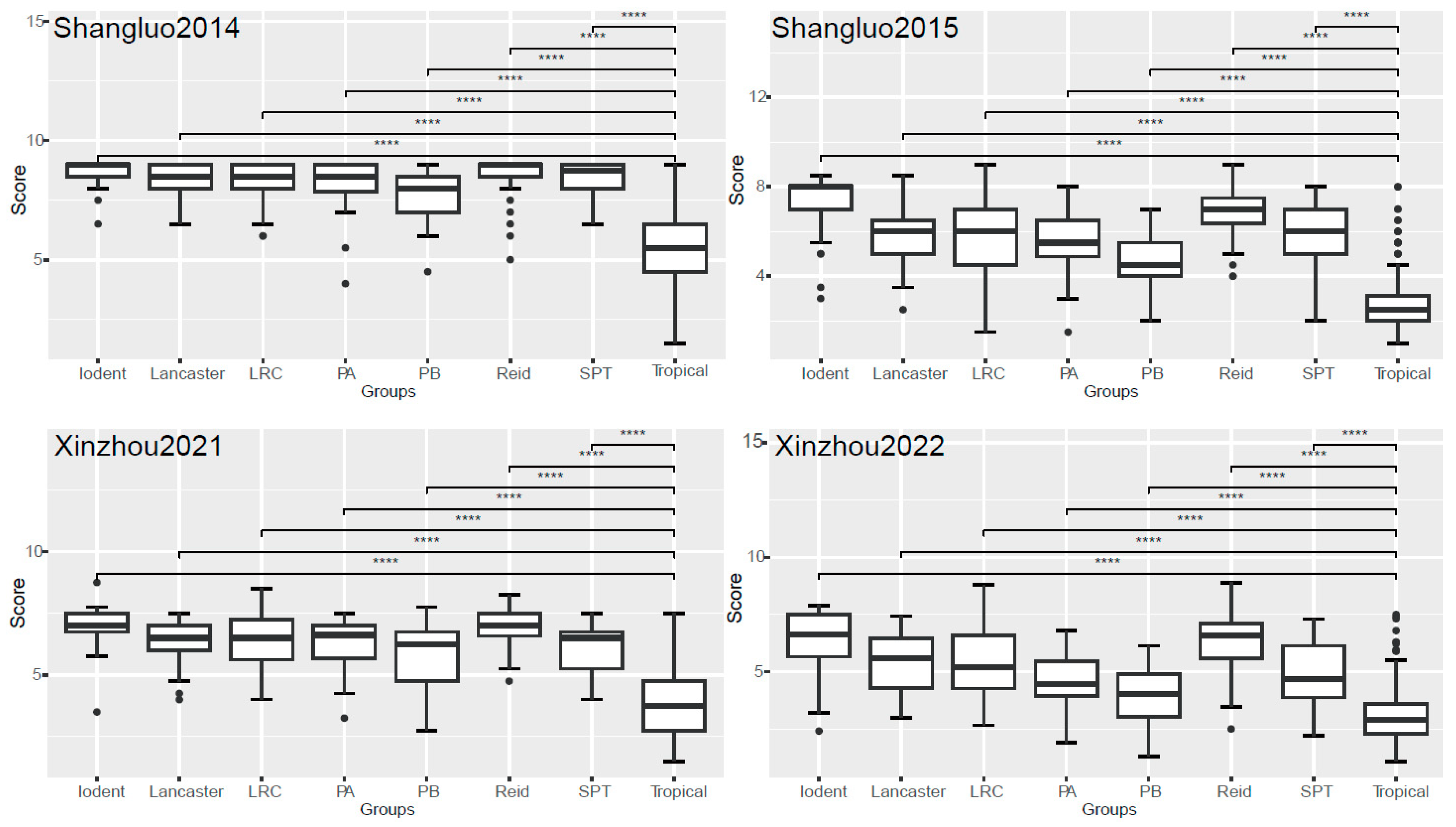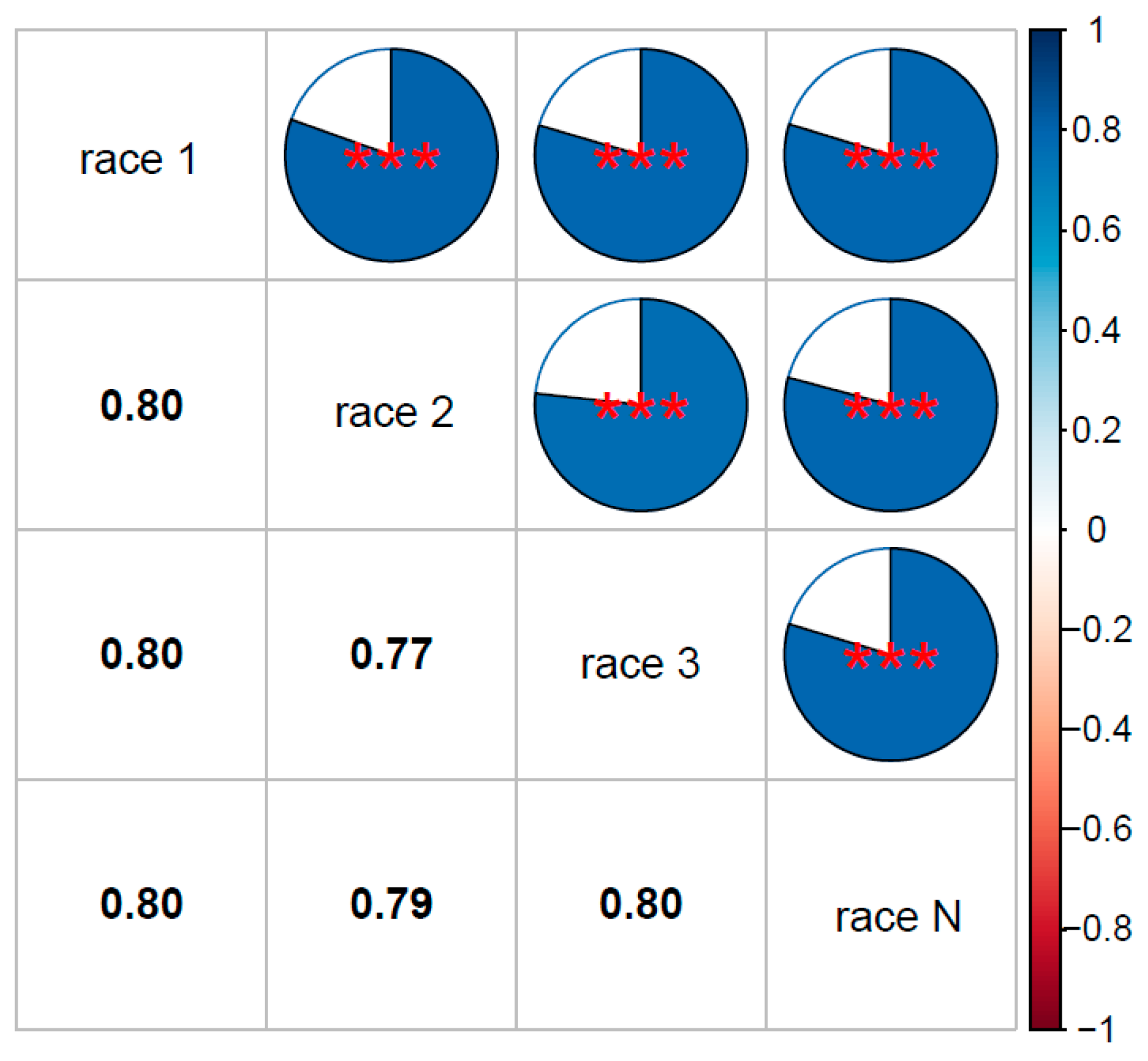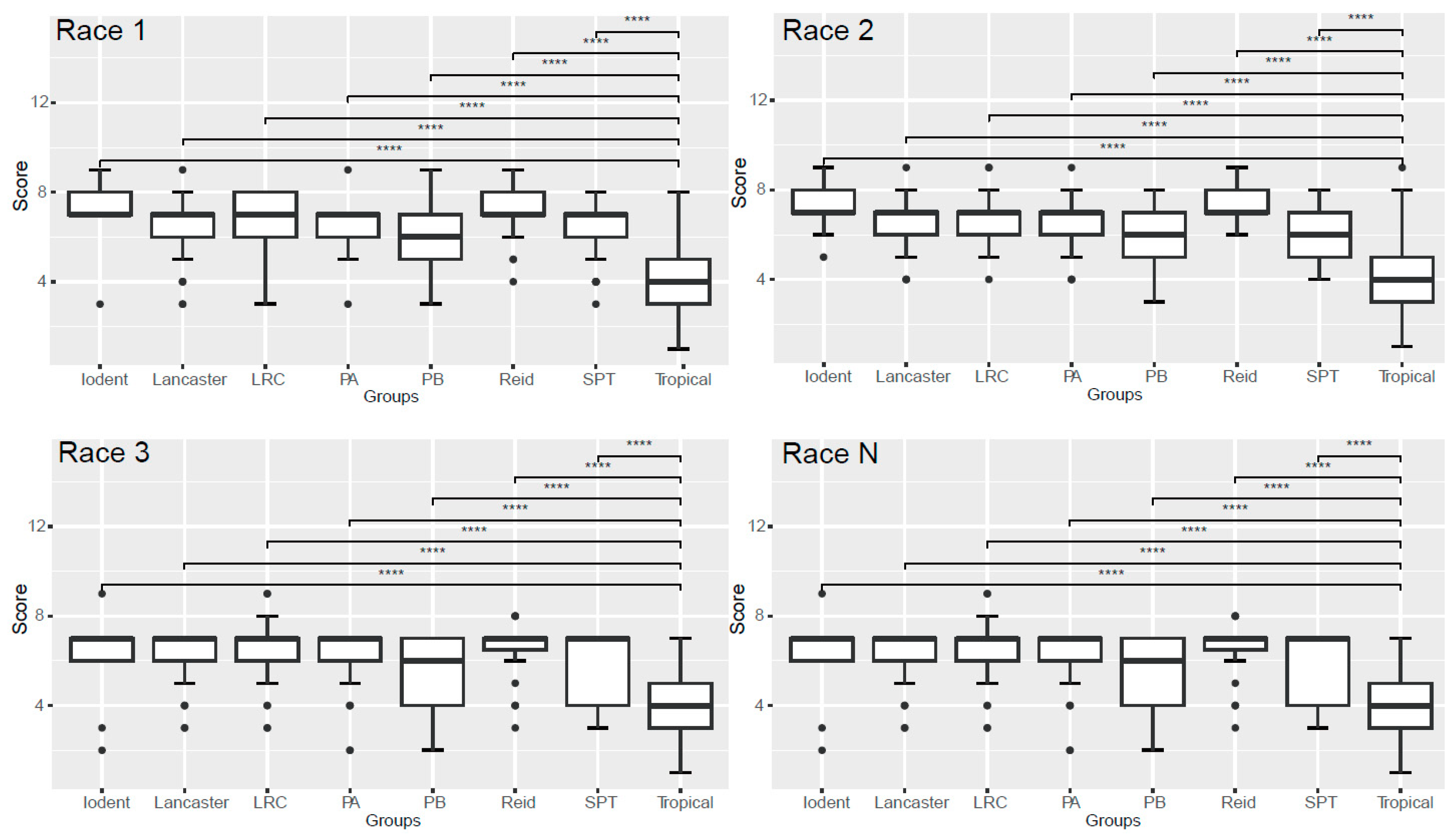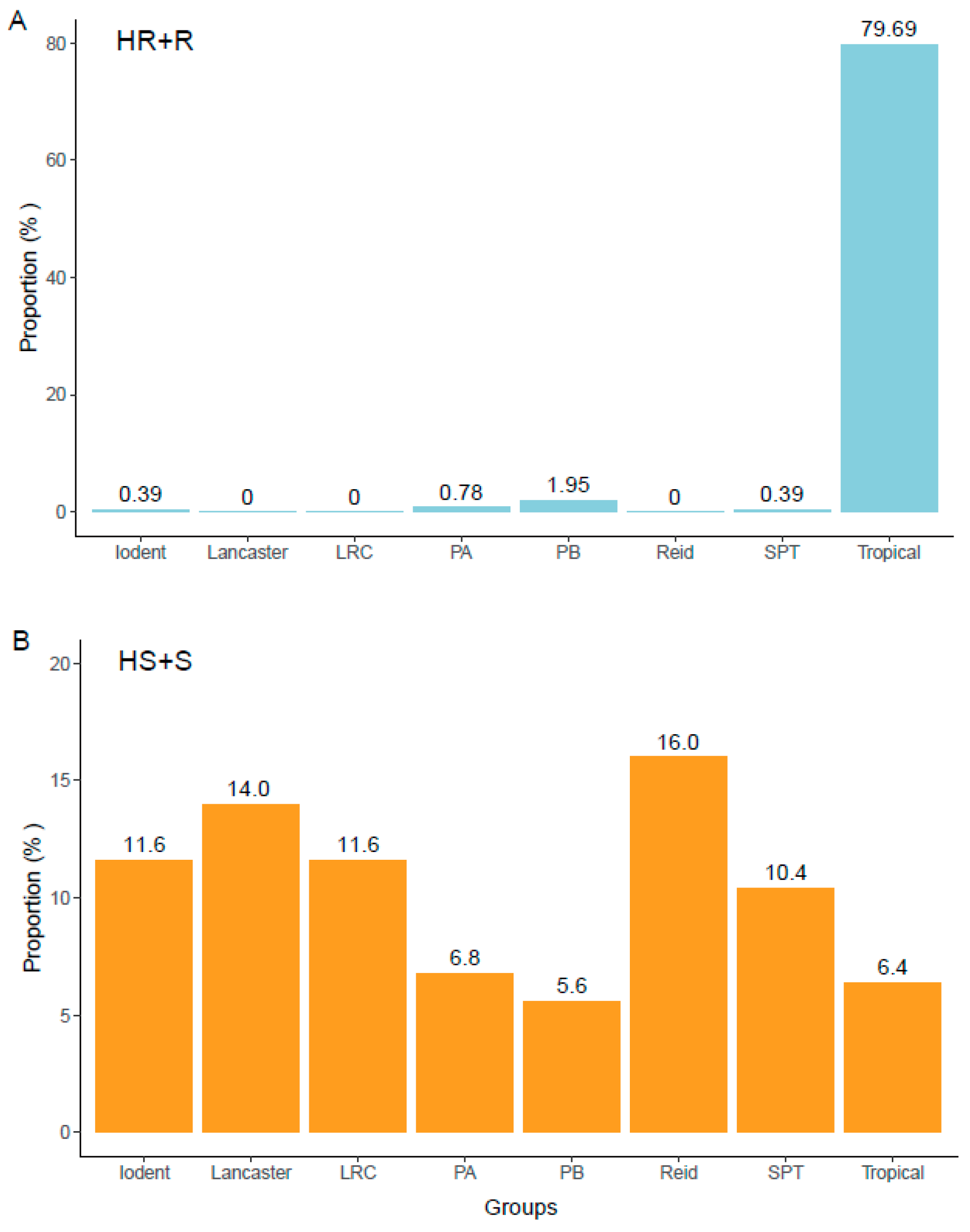Identification and Analysis of Resistance to Northern Corn Leaf Blight in Maize Germplasm Resources
Abstract
1. Introduction
2. Results and Analysis
2.1. Analysis of Individual Environments
2.2. Resistance Variation Among Heterotic Groups
2.3. Resistance Induced by Different Physiological Races
2.4. Comprehensive Analysis of Resistance Evaluation Results Across Four Environments
3. Discussion
4. Materials and Methods
4.1. Plant Materials
4.2. Field Experimental Design and Management
4.3. Fungal Isolates and Culture
4.4. Inoculation and Disease Assessment
4.5. Data Analysis
5. Conclusions
Supplementary Materials
Author Contributions
Funding
Data Availability Statement
Conflicts of Interest
Abbreviations
| Abbreviation | Full term |
| NCLB | Northern corn leaf blight |
| QTL | Quantitative trait loci |
| SS | Stiff Stalk |
| NSS | Non-Stiff Stalk |
| ANOVA | Analysis of variance |
| SPT | Derivatives from the Tangshan Sipingtou Chinese landrace |
| PA | Group A germplasms derived from modern US hybrids |
| PB | Group B germplasms derived from modern US hybrids |
| LRC | Lvda Red Cob |
References
- Lohithaswa, H.C.; Balasundara, D.C.; Mallikarjuna, M.G.; Sowmya, M.S.; Mallikarjuna, N.; Kulkarni, R.S.; Pandravada, A.S.; Bhatia, B.S. Experimental evaluation of effectiveness of genomic selection for resistance to northern corn leaf blight in maize. J. Appl. Genet. 2025, 66, 493–521. [Google Scholar] [CrossRef]
- Galiano-Carneiro, A.L.; Kessel, B.; Presterl, T.; Miedaner, T. Intercontinental trials reveal stable QTL for northern corn leaf blight resistance in Europe and in Brazil. Theor. Appl. Genet. 2021, 134, 63–79. [Google Scholar] [CrossRef]
- Ndlovu, N.; Gowda, M.; Beyene, Y.; Das, B.; Mahabaleswara, S.L.; Makumbi, D.; Ogugo, V.; Burgueno, J.; Crossa, J.; Spillane, C.; et al. A combination of joint linkage and genome-wide association study reveals putative candidate genes associated with resistance to northern corn leaf blight in tropical maize. Front. Plant Sci. 2024, 15, 1448961. [Google Scholar] [CrossRef]
- Rizzardi, D.A.; Peterlini, E.; Scapim, C.A.; Pinto, R.J.B.; Faria, M.V.; Contreras-Soto, R.I. Genome wide association study identifies SNPs associated with northern corn leaf blight caused by Exserohilum turcicum in tropical maize germplasm (Zea mays L.). Euphytica 2022, 218, 40. [Google Scholar] [CrossRef]
- Welz, H.G.; Geiger, H.H. Genes for resistance to northern corn leaf blight in diverse maize populations. Plant Breed. 2000, 119, 1–14. [Google Scholar] [CrossRef]
- Ramathani, I.; Biruma, M.; Martin, T.; Dixelius, C.; Okori, P. Disease severity, incidence and races of Setosphaeria turcica on sorghum in Uganda. Eur. J. Plant Pathol. 2011, 131, 383–392. [Google Scholar] [CrossRef]
- De Rossi, R.; Guerra, F.; Plazas, M.; Vuletic, E.; Brücher, E.; Guerra, G.; Reis, E. Crop damage, economic losses, and the economic damage threshold for northern corn leaf blight. Crop Prot. 2021, 154, 105901. [Google Scholar] [CrossRef]
- Hurni, S.; Scheuermann, D.; Krattinger, S.G.; Kesssel, B.; Wicker, T.; Herren, G.; Fitze, M.N.; Breen, J.; Presterl, T.; Ouzunova, M.; et al. The maize disease resistance gene Htn1 against northern corn leaf blight encodes a wall-associated receptor-like kinase. Proc. Natl. Acad. Sci. USA 2015, 112, 8780–8786. [Google Scholar] [CrossRef]
- Yang, P.; Scheuermann, D.; Kessel, B.; Koller, T.; Greenwood, J.R.; Hurni, S.; Herren, G.; Zhou, S.; Marande, W.; Wicher, T.; et al. Alleles of a wall-associated kinase gene account for three of the major northern corn leaf blight resistance loci in maize. Plant J. 2021, 106, 526–535. [Google Scholar] [CrossRef]
- Thatcher, S.; Leonard, A.; Lauer, M.; Panangipalli, G.; Norman, B.; Hou, Z.; Llaca, V.; Hu, W.; Qi, X.; Jaqueth, J.; et al. The northern corn leaf blight resistance gene Ht1 encodes a nucleotide-binding, leucine-rich repeat immune receptor. Mol. Plant Pathol. 2023, 24, 758–767. [Google Scholar] [CrossRef]
- Ding, J.; Ali, F.; Chen, G.; Li, H.; Mahuku, G.; Yang, N.; Narro, L.; Magorokosho, C.; Makumbi, D.; Yan, J. Genome-wide association mapping reveals novel sources of resistance to northern corn leaf blight in maize. BMC Plant Biol. 2015, 15, 206. [Google Scholar] [CrossRef]
- Wu, J.; Yang, W.; Shi, X.; Zhang, B.; Jiang, M.; Qi, X.; Ma, J.; Jaqueth, J.S.; Li, B.; Dai, M.; et al. Identification and fine-mapping of qNCLB3.04 resistant to northern corn leaf blight. Mol. Breed. 2025, 45, 59. [Google Scholar] [CrossRef]
- Gong, X.; Jiang, F.; Shaw, R.K.; Sun, J.; Dai, T.; Bi, Y.; Pan, Y.; Kong, J.; Zong, H.; Yang, X.; et al. Genome-wide association study of northern corn leaf blight (NCLB) resistance using temperate and subtropical maize recombinant inbred lines. BMC Genom. 2025, 26, 609. [Google Scholar] [CrossRef]
- Van Inghelandt, D.; Melchinger, A.E.; Martinant, J.P.; Stich, B. Genome-wide association mapping of flowering time and northern corn leaf blight (Setosphaeria turcica) resistance in a vast commercial maize germplasm set. BMC Plant Biol. 2012, 30, 12–56. [Google Scholar] [CrossRef]
- Wang, J.; Xu, Z.; Yang, J.; Lu, X.; Zhou, Z.; Zhang, C.; Zheng, L.; Tian, R.; Hao, Z.; Yong, H.; et al. qNCLB7.02, a novel QTL for resistance to northern corn leaf blight in maize. Mol. Breed. 2018, 38, 54. [Google Scholar] [CrossRef]
- Galiano-Carneiro, A.L.; Miedaner, T. Genetics of resistance and pathogenicity in the maize/Setosphaeria turcica pathosystem and implications for breeding. Front. Plant Sci. 2017, 8, 1490. [Google Scholar] [CrossRef]
- Ogliari, J.B.; Guimarães, M.A.; Geraldi, I.O.; Camargo, L.E.A. New resistance genes in the Zea mays: Exserohilum turcicum pathosystem. Genet. Mol. Biol. 2005, 28, 435–439. [Google Scholar] [CrossRef]
- Niwas, R.; Anwer, M.A.; Ranjan, T.; Ghatak, A.; Jain, K.; Kumar, J.; Bharti, A.; Kumari, N.; Srivastava, J.N. Exserohilum turcicum (Passerini) leonard and suggs: Race population distribution in Bihar, India. Bioengineering 2022, 10, 7. [Google Scholar] [CrossRef]
- Muñoz-Zavala, C.; Loladze, A.; Vargas-Hernández, M.; García-León, E.; Alakonya, A.E.; Tovar-Pedraza, J.M.; Goodwin, P.H.; Leyva-Mir, S.G. Occurrence and distribution of physiological races of Exserohilum turcicum in maize-growing regions of Mexico. Plant Dis. 2023, 107, 1054–1059. [Google Scholar] [CrossRef]
- Zhang, X. Study on Resistance of Maize to Northern Corn Leaf Blight and Southern Corn Rust. Doctoral Dissertation, Chinese Academy of Agricultural Sciences, Beijing, China, 2014. [Google Scholar]
- Vasal, S.K.; Srinivasan, G.; González, C.F.; Han, C.G.; Pandey, S.; Beck, D.L.; Crossa, J. Heterosis and combining ability of CIMMYT’s Tropical × Subtropical maize germplasm. Crop Sci. 1992, 32, 1483–1489. [Google Scholar] [CrossRef]
- Vasal, S.K.; Srinivasan, G.; Crossa, J.; Beck, D.L. Heterosis and combining ability of CIMMYT’s subtropical and temperate early-maturity maize germplasm. Crop Sci. 1992, 32, 884–890. [Google Scholar] [CrossRef]
- Guo, Z.; Wang, H.; Tao, J.; Ren, Y.; Xu, C.; Wu, K.; Zou, C.; Zhang, J.; Xu, Y. Development of multiple SNP marker panels affordable to breeders through genotyping by target sequencing (GBTS) in maize. Mol. Breed. 2019, 39, 37. [Google Scholar] [CrossRef]
- Xu, C.; Zhang, H.; Sun, J.; Guo, Z.; Zou, C.; Li, W.X.; Xie, C.; Huang, C.; Xu, R.; Liao, H.; et al. Genome-wide association study dissects yield components associated with low-phosphorus stress tolerance in maize. Theor. Appl. Genet. 2018, 131, 1699–1714. [Google Scholar] [CrossRef] [PubMed]
- Guo, Z.; Zou, C.; Liu, X.; Wang, S.; Li, W.; Jeffers, D.; Fan, X.; Xu, M.; Xu, Y. Complex genetic system involved in Fusarium ear rot resistance in maize as revealed by GWAS, bulked sample analysis, and genomic prediction. Plant Dis. 2020, 104, 1725–1735. [Google Scholar] [CrossRef] [PubMed]
- Rashid, Z.; Singh, P.K.; Vemuri, H.; Zaidi, P.H.; Prasanna, B.M.; Nair, S.K. Genome-wide association study in Asia-adapted tropical maize reveals novel and explored genomic regions for sorghum downy mildew resistance. Sci. Rep. 2018, 8, 366. [Google Scholar] [CrossRef]
- Wang, H.; Xu, C.; Liu, X.; Guo, Z.; Xu, X.; Wang, S.; Xie, C.; Li, W.; Zou, C.; Xu, Y. Development of a multiple-hybrid population for genome-wide association studies: Theoretical consideration and genetic mapping of flowering traits in maize. Sci. Rep. 2017, 7, 40239. [Google Scholar] [CrossRef]
- Sang, Z.; Zhang, Z.; Yang, Y.; Li, Z.; Liu, X.; Xu, Y.; Li, W. Heterosis and heterotic patterns of maize germplasm revealed by a multiple-hybrid population under well-watered and drought-stressed conditions. J. Integr. Agric. 2022, 21, 2477–2491. [Google Scholar] [CrossRef]
- Guo, Z.; Yang, Q.; Huang, F.; Zheng, H.; Sang, Z.; Xu, Y.; Zhang, C.; Wu, K.; Tao, J.; Prasanna, B.M.; et al. Development of high-resolution multiple-SNP arrays for genetic analyses and molecular breeding through genotyping by target sequencing and liquid chip. Plant Commun. 2021, 2, 100230. [Google Scholar] [CrossRef]
- Ma, Z.; Hui, H.; Huang, Y.; Yao, Y.; Sun, Y.; Liu, B.; Gao, Z. Evaluation of maize hybrids for identifying resistance to northern corn leaf blight in northeast China. Plant Dis. 2022, 106, 1003–1008. [Google Scholar] [CrossRef]
- Miedaner, T.; Boeven, A.L.G.; Gaikpa, D.S.; Kistner, M.B.; Grote, C.P. Genomics-assisted breeding for quantitative disease resistances in small-grain cereals and maize. Int. J. Mol. Sci. 2020, 21, 9717. [Google Scholar] [CrossRef] [PubMed]
- Chung, C.L.; Poland, J.; Kump, K.; Benson, J.; Longfellow, J.; Walsh, E.; Balint-Kurti, P.; Nelson, R. Targeted discovery of quantitative trait loci for resistance to northern leaf blight and other diseases of maize. Theor. Appl. Genet. 2011, 123, 307–326. [Google Scholar] [CrossRef] [PubMed]
- Wang, H.; Hou, J.; Ye, P.; Hu, L.; Huang, J.; Dai, Z.; Zhang, B.; Dai, S.; Que, J.; Min, H.; et al. A teosinte-derived allele of a MYB transcription repressor confers multiple disease resistance in maize. Mol. Plant 2021, 14, 1846–1863. [Google Scholar] [CrossRef] [PubMed]
- Carson, M.L. Inheritance of latent period length in maize infected with Exserohilum turcicum. Plant Dis. 1995, 79, 581–585. [Google Scholar] [CrossRef]
- Technow, F.; Bürger, A.; Melchinger, A.E. Genomic prediction of northern corn leaf blight resistance in maize with combined or separated training sets for heterotic groups. G3 2013, 3, 197–203. [Google Scholar] [CrossRef]
- Abdelsalam, N.R.; Balbaa, M.G.; Osman, H.T.; Ghareeb, R.Y.; Desoky, E.M.; Elshehawi, A.M.; Aljuaid, B.S.; Elnahal, A.S.M. Inheritance of resistance against northern leaf blight of maize using conventional breeding methods. Saudi J. Biol. Sci. 2022, 29, 1747–1759. [Google Scholar] [CrossRef]
- Xue, Y.; Zhao, Y.; Zhang, Y.; Wang, R.; Li, X.; Liu, Z.; Wang, W.; Zhu, S.; Fan, Y.; Xu, L.; et al. Insights into the genomic divergence of maize heterotic groups in China. J. Integr. Plant Biol. 2025, 67, 1467–1486. [Google Scholar] [CrossRef]
- Li, Y.; Wang, T. Germplasm base of maize breeding in China and formation of foundation parents. J. Maize Sci. 2010, 18, 1–8. [Google Scholar]
- Hooker, A.L. A second major gene locus in corn for chlorotic-lesion resistance to Helminthosporium turicum. Crop Sci. 1977, 17, 132–135. [Google Scholar] [CrossRef]
- Carson, M.L. A new gene in maize conferring the “Chlorotic Halo” reaction to infection by Exserohilum turcicum. Plant Dis. 1995, 79, 717–720. [Google Scholar] [CrossRef]
- Robbins, W.A., Jr.; Warren, H.L. Inheritance of resistance to Exserohilum turcicum in PI 209135, ‘Mayorbela’ variety of maize. Maydica 1993, 38, 209–213. [Google Scholar]
- Wang, H.; Xiao, Z.; Wang, F.; Xiao, Y.; Zhao, J.; Zheng, Y.; Qiu, F. Mapping of HtNB, a gene conferring non-lesion resistance before heading to Exserohilum turcicum (Pass.), in a maize inbred line derived from the Indonesian variety Bramadi. Genet. Mol. Res. 2012, 11, 2523–2533. [Google Scholar] [CrossRef]
- Gevers, H.O. A new major gene for resistance to Helminthosporium turcicum leaf blight in maize. Plant Dis. Rep. 1975, 59, 296–299. [Google Scholar]
- Yang, Q.; Balint-Kurti, P.; Xu, M. Quantitative disease resistance: Dissection and adoption in maize. Mol. Plant 2017, 10, 402–413. [Google Scholar] [CrossRef]
- Poland, J.A.; Bradbury, P.J.; Buckler, E.S.; Nelson, R.J. Genome-wide nested association mapping of quantitative resistance to northern leaf blight in maize. Proc. Natl. Acad. Sci. USA 2011, 108, 6893–6898. [Google Scholar] [CrossRef] [PubMed]
- Xiao, M.; Song, F.; Sun, B.; Zuo, X.; Zhao, G.; Xin, A.; Li, Z. Exploration of foreign maize inbred lines with broad spectrum resistance to northern corn leaf blight and preliminary identification of resistance genes. Acta Agron. Sin. 2018, 44, 614–619. [Google Scholar] [CrossRef]
- Zhu, C.; Ren, D.; Liu, Z.; Liu, C.; Liu, R.; Zheng, H.; Hu, E.; Lin, H.; Li, J.; Lu, Y.; et al. Combining ability analysis on quality traits and breeding potential evaluation of 23 waxy maize lines from Laos. Sci. Agric. Sin. 2024, 57, 2931–2952. [Google Scholar]
- Wang, S.; Zhang, R.; Wang, R.; Song, W.; Zhao, J. Research progress of southern corn rust and resistance breeding. Sci. Agric. Sin. 2024, 57, 2732–2743. [Google Scholar]
- Wang, C.; Cheng, F.; Sun, Z.; Tang, J.; Wu, L.; Ku, L.; Chen, Y. Genetic analysis of photoperiod sensitivity in a tropical by temperate maize recombinant inbred population using molecular markers. Theor. Appl. Genet. 2008, 117, 1129–1139. [Google Scholar] [CrossRef]
- Zheng, T.; Bo, J.; Wang, J.; Li, S.; Li, H.; Liu, M.; Niu, H.; Nguyen, T.; Chen, Y.; Sun, J. Unveiling photoperiod-responsive regulatory networks in tropical maize through transcriptome analysis. Genes 2025, 16, 192. [Google Scholar] [CrossRef]
- Yang, Y.; Sang, Z.; Du, Q.; Guo, Z.; Li, Z.; Kong, X.; Xu, Y.; Zou, Z. Flowing time regulation model revisited by pooled sequencing of mass selection populations. Plant Sci. 2021, 304, 110797. [Google Scholar] [CrossRef]
- Zhang, Y.; Zhang, X. Heterotic pattern, improvement and utilization of corn 78599 germplasm. J. Maize Sci. 2008, 16, 37–40. [Google Scholar]
- Teng, W.; Cao, J.; Chen, Y.; Liu, X.; Jing, X.; Zhang, F.; Li, J. Analysis of maize heterotic groups and patterns during past decade in China. Sci. Agric. Sin. 2004, 37, 1804–1811. [Google Scholar]
- Wang, X.; Jing, X.; Wang, X.; Ge, L.; Jing, X.; Yao, Y.; Chen, R. Usage of PN78599 group germplasm in breeding and produce of maize in China. J. Maize Sci. 2012, 20, 50–52. [Google Scholar]
- Li, W.; Xu, C.; An, Y.; Sun, M.; Min, L.; Jiang, S.; Hu, G. Genetic diversity analysis of 257 maize inbred lines by SSR core primers. Heilongjiang Agric. Sci. 2012, 07, 6–13. [Google Scholar]
- Xiao, M.; Li, M.; Li, X.; George, M.L.; Zhang, S. Comparisons of heterotic patterns on maize germplasm between Northeast provinces and huanghuaihai valley. J. Maize Sci. 2010, 18, 23–28+34. [Google Scholar]
- Shi, J.; He, K. Characterization and genetic predisposition of diseases resistance of maize foundation parents. J. Maize Sci. 2021, 29, 55–62. [Google Scholar]
- Cai, X.; Liu, J.; Xia, Y.; Zhong, Y.; Wu, F.; Liu, X.; Sang, J.; Jiao, R.; Jia, L. Creation and application of maize inbred line JiD284 and JiD2417. J. Maize Sci. 2010, 30, 13–18. [Google Scholar]
- Duan, C.; Dong, H.; Li, X.; Li, H.; Li, C.; Sun, S.; Zhu, Z.; Wang, X. A large-scale screening of maize germplasm for resistance to multiple diseases in multi-plot demonstration for several years under natural condition. Acta Agron. Sin. 2020, 46, 1135–1145. [Google Scholar] [CrossRef]
- Wang, X.; Dai, F.; Zhu, Z.; He, K.; Wang, X. Rules for Evaluation of Maize for Resistance to Pests; Part 1: Rule for evaluation of maize for resistance to northern corn leaf blight (NY/T 1248.1-2006); (In Chinese). China Agriculture Press: Beijing, China, 2007. [Google Scholar]
- Li, C.; Ling, F.; Su, G.; Sun, W.; Liu, H.; Su, Y.; Qi, X. Location and mapping of the NCLB resistance genes in maize by bulked segregant analysis (BSA) using whole genome re-sequencing. Mol. Breed. 2020, 40, 92. [Google Scholar] [CrossRef]
- R Core Team. R: A Language and Environment for Statistical Computing; R package 4.4.2; R Foundation for Statistical Computing: Vienna, Austria, 2025; Available online: https://www.R-project.org/ (accessed on 17 April 2025).
- Revelle, W. psych: Procedures for Psychological, Psychometric, and Personality Research, R package version 2.5.3; Northwestern University: Evanston, IL, USA, 2025; Available online: https://CRAN.R-project.org/package=psych (accessed on 17 April 2025).
- Wickham, H. ggplot2: Elegant Graphics for Data Analysis, R package version 3.5.1; Springer: New York, NY, USA, 2016; Available online: https://ggplot2.tidyverse.org/ (accessed on 17 April 2025).
- Meng, L.; Li, H.; Zhang, L.; Wang, J. QTL IciMapping: Integrated software for genetic linkage map construction and quantitative trait locus mapping in biparental populations. Crop J. 2015, 3, 69–283. [Google Scholar] [CrossRef]
- Knapp, S.J.; Stroup, W.W.; Ross, W.M. Exact confidence intervals for heritability on a progeny mean basis. Crop Sci. 1985, 25, 192–194. [Google Scholar] [CrossRef]





| Environments | Number ※ | NCLB Score | Variance Components | H2 | ||||
|---|---|---|---|---|---|---|---|---|
| Mean ± SD | Range | |||||||
| Shangluo2014 | 556 | 7.01 ± 1.94 | 1.50–9.00 | 4.21 *** | 0.48 | 0.93 | ||
| Shangluo2015 | 540 | 4.51 ± 2.28 | 1.00–9.00 | 5.03 *** | 1.34 | 0.85 | ||
| Xinzhou2021 | 711 | 5.13 ± 1.99 | 1.50–8.75 | 2.79 *** | 1.14 | 0.95 | ||
| Xinzhou2022 | 711 | 4.10 ± 1.75 | 1.08–8.90 | 2.79 *** | 0.87 | 0.93 | ||
| Total | 711 | 5.12 ± 2.14 | 1.00–9.00 | 2.68 *** | 1.04 | 0.84 *** | 0.41 *** | 0.94 |
| Heterotic Group | Number | NCLB Score (Mean ± SD) | H2 | |||||
|---|---|---|---|---|---|---|---|---|
| 2021 | 2022 | 2021 | 2022 | 2021 | 2022 | |||
| Iodent | 32 | 6.99 ± 0.82 | 6.33 ± 1.36 | 0.59 *** | 1.79 *** | 0.55 *** | 0.86 | 0.90 |
| Lancaster | 49 | 6.35 ± 0.83 | 5.31 ± 1.23 | 0.58 *** | 1.32 *** | 0.38 *** | 0.83 | 0.87 |
| LRC | 47 | 6.38 ± 1.05 | 5.32 ± 1.50 | 0.97 *** | 2.08 *** | 0.28 *** | 0.87 | 0.92 |
| PA | 28 | 6.21 ± 1.00 | 4.62 ± 1.16 | 0.90 *** | 0.91 *** | 0.25 *** | 0.87 | 0.73 |
| PB | 39 | 5.60 ± 1.31 | 3.95 ± 1.15 | 1.64 *** | 0.97 *** | 0.30 *** | 0.93 | 0.82 |
| Reid | 43 | 6.93 ± 0.72 | 6.38 ± 1.31 | 0.42 *** | 1.60 *** | 0.36 *** | 0.79 | 0.90 |
| SPT | 39 | 6.03 ± 1.08 | 5.04 ± 1.25 | 1.05 *** | 1.34 *** | 0.14 ** | 0.89 | 0.86 |
| Tropical | 309 | 3.98 ± 1.44 | 3.03 ± 1.16 | 1.92 *** | 1.08 *** | 0.37 *** | 0.93 | 0.83 |
| Group | Number | HR | R | MR | S | HS | Range | Mean |
|---|---|---|---|---|---|---|---|---|
| Iodent | 32 | 0 | 1 | 4 | 26 | 1 | 2.96–8.29 | 6.66 |
| Lancaster | 49 | 0 | 2 | 25 | 22 | 0 | 3.65–7.34 | 5.83 |
| LRC | 47 | 0 | 4 | 22 | 20 | 1 | 3.73–8.65 | 5.85 |
| PA | 28 | 0 | 2 | 17 | 9 | 0 | 2.88–6.78 | 5.42 |
| PB | 39 | 0 | 11 | 22 | 6 | 0 | 2.70–6.56 | 4.78 |
| Reid | 43 | 0 | 0 | 7 | 32 | 4 | 4.11–8.33 | 6.66 |
| SPT | 39 | 0 | 5 | 17 | 17 | 0 | 3.46–7.15 | 5.54 |
| Tropical | 309 | 19 | 204 | 72 | 14 | 0 | 1.48–7.50 | 3.51 |
| Resistance Rating Scores | Description of Leaf Disease | Resistance |
|---|---|---|
| 1 | The area of the leaf lesions is less than 5% of the leaf area. | Highly resistant (HR) (1 ≤ NCLBSM < 2) |
| 3 | There are a small number of lesions on the spike leaves, accounting for 6–10% of the leaf area. | Resistant (R) (2 ≤ NCLBSM < 4) |
| 5 | There are numerous lesions on the leaves, accounting for 11–30% of the leaf area. | Moderately resistant (MR) (4 ≤ NCLBSM < 6) |
| 7 | There are a large number of lesions on the leaves above the ear position, and the lesions are connected, accounting for 31–70% of the leaf area. | Susceptible (S) (6 ≤ NCLBSM < 8) |
| 9 | Almost all the leaves of the whole plant are covered by lesions, and the leaves are withering and dying. | Highly susceptible (HS) (8 ≤ NCLBSM ≤ 9) |
Disclaimer/Publisher’s Note: The statements, opinions and data contained in all publications are solely those of the individual author(s) and contributor(s) and not of MDPI and/or the editor(s). MDPI and/or the editor(s) disclaim responsibility for any injury to people or property resulting from any ideas, methods, instructions or products referred to in the content. |
© 2025 by the authors. Licensee MDPI, Basel, Switzerland. This article is an open access article distributed under the terms and conditions of the Creative Commons Attribution (CC BY) license (https://creativecommons.org/licenses/by/4.0/).
Share and Cite
Meng, B.; Yang, J.; Tong, L.; Liu, Q.; Zhang, D.; Li, W.-X.; Wang, J.; Xu, Y.; Guo, Z.; Duan, C. Identification and Analysis of Resistance to Northern Corn Leaf Blight in Maize Germplasm Resources. Plants 2025, 14, 3171. https://doi.org/10.3390/plants14203171
Meng B, Yang J, Tong L, Liu Q, Zhang D, Li W-X, Wang J, Xu Y, Guo Z, Duan C. Identification and Analysis of Resistance to Northern Corn Leaf Blight in Maize Germplasm Resources. Plants. 2025; 14(20):3171. https://doi.org/10.3390/plants14203171
Chicago/Turabian StyleMeng, Bing, Junwei Yang, Lixiu Tong, Qingli Liu, Dongfeng Zhang, Wen-Xue Li, Jianjun Wang, Yunbi Xu, Zifeng Guo, and Canxing Duan. 2025. "Identification and Analysis of Resistance to Northern Corn Leaf Blight in Maize Germplasm Resources" Plants 14, no. 20: 3171. https://doi.org/10.3390/plants14203171
APA StyleMeng, B., Yang, J., Tong, L., Liu, Q., Zhang, D., Li, W.-X., Wang, J., Xu, Y., Guo, Z., & Duan, C. (2025). Identification and Analysis of Resistance to Northern Corn Leaf Blight in Maize Germplasm Resources. Plants, 14(20), 3171. https://doi.org/10.3390/plants14203171








